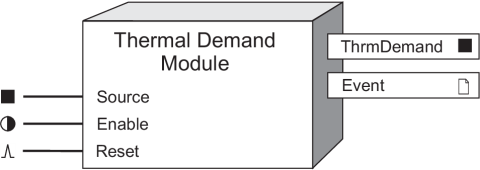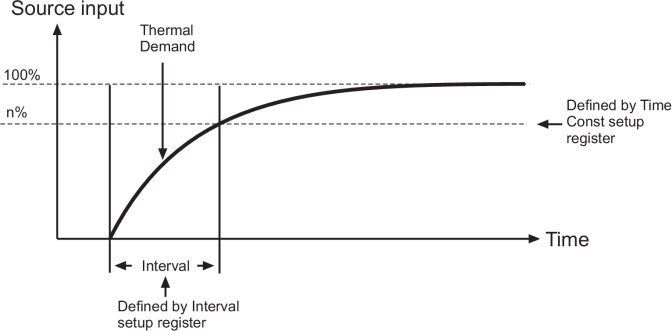Thermal Demand Module
The Thermal Demand Module calculates thermal demand over a specified length of time.
Module icon
![]()
Overview
Power utilities generally bill commercial customers based on both their energy consumption (in KWh) and their peak usage levels, called peak demand (in KW). Demand is a measure of average power consumption over a fixed time interval, typically 30 minutes. Peak (or maximum) demand is the highest demand level recorded over the billing period. Thermal demand is one method of measuring demand.
The module uses a method which is equivalent to thermal averaging. For thermal averaging, the traditional demand indicator responds to heating of a thermal element in a Watt-Hour meter. You can adjust the Thermal Demand Module’s calculation to mimic this technique by changing the Time Const and Interval setup parameters.
Thermal demand values can be calculated for any numeric variable.

NOTE: The registers and settings available in this module depend on the device or node you are configuring, as well as its firmware and template versions. Not all registers or settings are available on all devices or the Virtual Processor, and labels may vary.
Inputs
 Source
Source
This is the input upon which the thermal demand calculation is performed. It must be a numeric register from any other module’s outputs. Linking this input is mandatory.
 Enable
Enable
Disabling the module causes the Source input value to be replaced with zero. This will cause the demand output of the module to decay as a negative exponential function.
 Reset
Reset
This input resets the module, setting the ThrmDemand output register to zero. It must be a pulse register from any other module’s outputs. This input is optional; if you leave it unlinked, it will never receive a pulse.
NOTE: The Reset input still functions if the module’s Enable input is off
Setup registers
The setup registers of the module allow you to adjust the thermal demand calculation to match a thermal averaging technique.
 Interval
Interval
This register specifies the number of seconds in the thermal demand interval.
 Time Const
Time Const
This register specifies the rate at which the ThrmDemand output register responds to changes in the Source input. The higher the Time Const value, the faster the response time. Values commonly used are 63 and 90.
Output registers
 ThrmDemand
ThrmDemand
This numeric variable register contains the accumulated thermal demand.
 Event
Event
All events are recorded in the Event register.
Possible events and their associated priority numbers are:
| Event priority group | Priority | Description |
|---|---|---|
| Reset | 5 | A module reset has occurred. |
| Setup Change | 10 | Input links, setup registers or labels have changed. |
| Information | 25 | N/A input caused output to go not available. |
Responses to special conditions
The following table summarizes how the module behaves under different conditions.
| Condition | Response of output registers |
|---|---|
| If the Source input is not available | The ThrmDemand output register is not available. |
| When the device is started or powered up (either the first time, or after a shut-down) | The ThrmDemand output register is not available. |
Detailed module operation
The figure below illustrates the thermal demand calculation. When you change the values in the setup registers, the shape of the curve changes, allowing you to match a power utility’s demand calculation technique.
